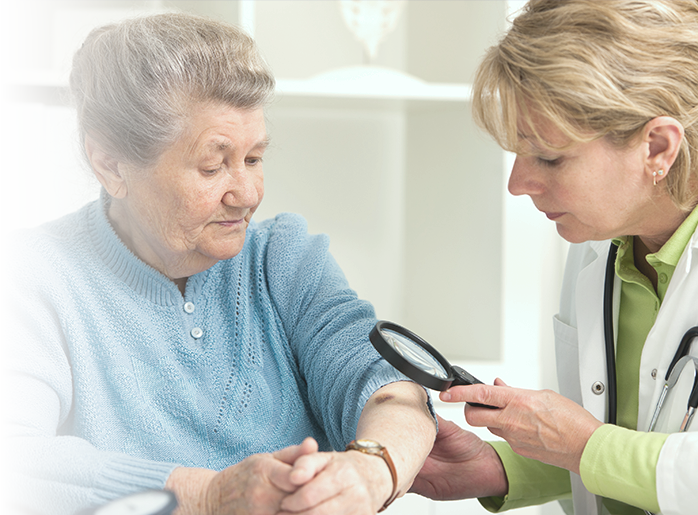Warts
Know More: Warts
Trustworthy information, straight from the source. Education is the first step in an empowering healthcare plan. Learn more about warts, from prevention to diagnosis and treatment.

Condition Overview
What is a common wart?
A common wart is a thick, rough, skin growth caused by human papillomavirus virus (HPV). HPV is a germ that spreads by skin-to-skin contact or contact with contaminated surfaces. Common warts are benign (not cancer).
What are genital warts?
Genital warts are a sexually transmitted infection (STI) caused by the human papillomavirus (HPV). Genital warts are growths that appear in or on the penis, vagina, or anus. Genital warts are spread during genital, anal, or oral sex. A woman can also pass them to a baby when she gives birth.
Risk Prevention
What increases my risk for a common wart?
Common warts occur more often in children and young adults. You may get warts if you touch someone else’s wart or objects that someone with a wart has touched. The following may increase your risk for a common wart:
- Use of community showers, swimming pools, or bathrooms.
- Handling raw meat or fish.
- Use of medicines that weaken your immune system.
- Conditions that weaken your immune system such as lymphoma, HIV, or an organ transplant.
- Being pregnant.
To prevent warts from spreading, dermatologists recommend the following:
- Do not pick or scratch at warts.
- Wear flip-flops or pool shoes in public showers, locker rooms, and pool areas.
- Do not touch someone’s wart.
- Keep foot warts dry, as moisture tends to allow warts to spread.
How to prevent the spread of genital warts
- Tell your sexual partners that you are being treated for genital warts. They may also be infected and need treatment.
- Get the HPV vaccine. The HPV vaccine is given at 9 to 26 years of age to help prevent cervical cancer and genital warts. Ask your healthcare provider for more information about this vaccine.
Diagnosis & Treatment Options
How are warts diagnosed?
Common Warts
- Common warts typically occur on the hands, particularly on the knuckles and around the fingernails.
Flat Warts
- Flat warts are flat in shape, flesh-colored, and commonly occur in multiples. Flat warts typically appear on the face, neck, legs, and knees.
Plantar Warts
- Plantar warts are hard, often painful lumps commonly found on the soles of the feet. They tend to be larger than common warts and are flesh-colored or brown with black specks.
- Filiform warts are very small, thread-like warts typically found on the face, around the corners of lips and on the eyelids.
Genital Warts
- Genital warts are caused by a type of sexually-transmitted HPV. These small warts can occur on the genitals, pubic area, and rectum, or inside the vagina in women.
How are warts treated?
Many warts can be successfully treated with an over-the-counter salicylic acid solution. Other treatment options may include cryotherapy, blistering compounds, surgical excision, laser surgery, and immunotherapy.
Your healthcare provider may treat common warts based on the size, location, and number of warts you have. Some common warts go away on their own without treatment. Some common warts return after treatment.
You may need any of the following:
- Home treatments may be done to help remove the wart. You may need to apply any of the following to your wart at home:
- Salicylic acid helps dry and remove the wart. Before you apply salicylic acid, soak the wart in warm water for up to 20 minutes. Keep your wart damp. Apply a small amount of salicylic acid directly to your wart. Do not apply salicylic acid to healthy skin. Cover the wart as directed. It is best to do this at bedtime. When you wake, use a pumice stone (a rough stone) or nail file to gently remove dead skin. Repeat as directed.
- Duct tape helps dry and remove the wart. You may be directed to leave the duct tape on for six days. On day seven, take the tape off and soak the wart in warm water for five minutes. Gently scrape the wart with a pumice stone or nail file. Then apply a new piece of duct tape and follow the same steps until the wart is gone.
- Cantharidin burns the wart and causes it to blister. Your healthcare provider will apply this liquid medicine to your wart. He or she may remove the blister or dead skin at a later time.
- Liquid nitrogen freezes your wart and helps it fall off. This treatment may be repeated two to four times.
- Injections (shots) may help kill the virus that is causing the wart.
- Other treatments may be needed to remove your wart. These treatments may include phototherapy, laser therapy, or surgery to remove the wart.
Depending on the treatment option you’re considering, your healthcare provider may refer you to a dermatologist.
Preparing for Care
When should I contact my healthcare provider?
- Your wart returns or does not go away after treatment.
- Your wart grows larger, or begins to spread or cluster.
- You have a wart on your face, genitals, or rectum.
- Your wart bleeds, becomes painful, or drains pus.
- You have questions about your condition or care.
